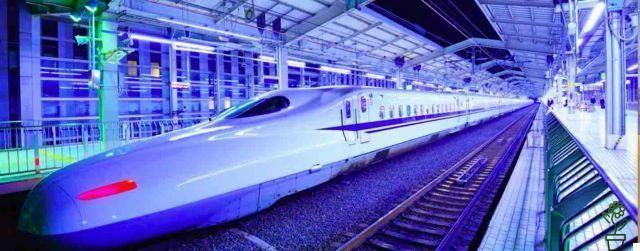
There are two types of impossible goals.
The ones that really are, like walking to the moon.
And those who are only if you believe they are, such as becoming a rock star, winning your dream partner or earning a million euros in the next 12 months.
For the first type, there is little to do but recognize them when you have them in front of you.
To explain instead how the second kind of impossible goals is achieved, we will travel together in Japan of the last century.
It starts with a challenge ...
At the end of the 50s, in the turbulent period of its post-war renaissance, Japan was faced with a difficult problem: to connect the most important cities of the island efficiently.
In fact, the options available up to that time were not adequate to support the development of the country:
- The plane was fast, but very expensive and with great capacity and logistics problems
- Road transport, on the other hand, was slow and subject to great uncertainties due to increasing traffic
The government then considered that it would be ideal to connect the country through a network high-speed rail that it passed through all the main cities north and south of Tokyo, with the latter as the primary hub.
An Impossible Goal is established ...
Given the geographic structure of Japan, which is very long and relatively narrow, the government's plan needed to work the average speed of train operation reached 200 km / hour.
If today it is still a respectable average speed, in those days it was considered a practically impossible goal, like going to the moon (another goal that was reached, against all odds, a few years later).
Yet, 5 years after the start of the project, on October 1, 1964, the first bullet train (Japanese dangan resshain) in history made its maiden voyage between the capital and Osaka, precisely in conjunction with the start of the Olympics. of Tokyo.
From then on, the Shinknazen, this was the name they gave the new railway system:
- It transformed Japan's modern history, making it an economic superpower
- It has become the forerunner - still unmatched for punctuality and safety - of all the high-speed networks that we also use today in Europe.
- It arrived, in its latest magnetic levitation version, at the incredible speed of 605 km per hour.
Everything from that first connection between Tokyo and Osaka which took place in just over 3 hours, or in less than half the time compared to the previous mileage record.
How was this seemingly impossible goal achieved?
Radical changes are planned ...
The Japanese engineers started, as any of us would have done, with a series of very reasonable assumptions that foresaw changes. incremental, i.e. small and predictable.
They hypothesized:
- Fit more powerful engines
- Improve the skill of train drivers
- Reduce waiting time at stations
… .And they realized that, with those solutions, perhaps they would have increased the average speed of travel by 10% -15%.
To triple it, it was essential to find more radical solutions.

In the following 5 years, therefore:
- They changed the shape, weight and size of the trains, revolutionizing their aerodynamics
- They built a system of tunnels and viaducts that made it possible to overcome mountains and rivers with a path as straight as possible
- They changed the pitch of the rails, making them narrower
- They built platforms flush with the threshold of the train, to allow faster ascent and descent
- They inserted numbered ground lines to mark the exact spot where the train door opened, so passengers could wait in an orderly fashion
- They changed the entire railway signage, no longer "on sight" - too dangerous at those speeds - but with electronic messaging on board
- They replaced the old propulsion system with a single-phase power supply at high voltage and a frequency of 50 Hz.
In other words, since the reality of the existing railway network did not allow him to reach the goal, instead of changing focus they changed that reality.
The importance of the reference reality
This kind of radical approach to change can be brought into every other aspect of life, allowing us to achieve seemingly impossible personal and professional goals.
To do this, just like the Shinkanzen engineers, you have to be ready to change our reality of reference.
Let me explain.
- If you have a normal job and want to make a million euros in the next 12 months, it is not enough for you to go to your boss and ask for a pay raise.
- If you are a student in difficulty and you want to take 10 exams next session, it will not be enough to study an hour more a day
- If you haven't been in sports for years but want to run the New York Marathon, training a couple of times a week won't do any good.
In short, to achieve these objectives small and incremental changes to your current reality will not be enough.
Instead, you will have to try to completely overturn it.
But how is it done?
1. First, you must be willing to face complete failure.
It is, in fact, the main reason why we consider some goals as impossible: the enormous risk of not reaching them and the fear connected to it prevents us from even trying.
Think back to the example of the job we saw earlier: if you go and ask for a small raise, the worst that can happen is that they won't give it to you.
But if you resign to found your start-up, in case of failure you really risk being left with less than nothing.
Unfortunately, if you are unwilling to take great risks, an impossible goal will remain so forever.
2. Then, you must be willing to put in enormous effort compared to what you are used to.
Think back to Japanese engineers for a moment.
They didn't just give the rails a dusting, but they had to level mountains, build tunnels, raise viaducts ...
Likewise, an impossible goal may require you to wake up at 5am, work Saturdays and Sundays, sweat the proverbial seven shirts.
And not for a couple of days or weeks, but maybe for years, and with no guarantee that we'll make it.
You will therefore need very high levels of motivation and an enormous ability to resist difficulties.
3. Finally, you have to mind-bending like never in life
Einstein used to say: “if you always do the same things, you will always get the same results”.
And in fact, to achieve extraordinary results, willpower and brute strength are almost never enough.
You also have to look for alternative methods, find shortcuts, be innovative, get out of your comfort zone.
In short, like the Japanese Shinknazen, any impossible goal needs imagination, brilliant ideas and inspiration. (Read my 14 techniques to find inspiration).
Impossible goals: try them at least once in your life.
For the reasons we have just seen, most of the impossible goals it is right that they remain so.
Our reality, in fact, is the result of many choices repeated over time, and completely distorting it to achieve an impossible goal requires:
- Maximum risk
- Maximum effort
- Maximum mental commitment
These are three coins that cannot be spent continuously, because we would find ourselves together physically and emotionally exhausted in a very short time.
Most of our personal and professional goals must therefore be achieved in a less traumatic way, through a series of small and incremental changes of our daily life.
Changes that, added up over time, can still give great results. (To understand how, read the article on the strength of marginal gains)
However, you may also find yourself wishing for an impossible goal.
One of those things we dream of as children, when every reality seems plausible to us and we still have no problem thinking about becoming astronauts, writers or rock stars.
Remember then that these are not objectively impossible goals, and this is demonstrated by the fact that others before you have made it and others still, in the future, will make it.
I am simply impossible goals compared to your reference reality.
But, if you are willing to invest the maximum effort and the maximum of your skills in the face of a very high risk of failure, if you are willing to try to upset that reality, you too will have your chances to reach them.
At least once in a lifetime it's worth a try, it's up to you when. Greetings, Armando.


























